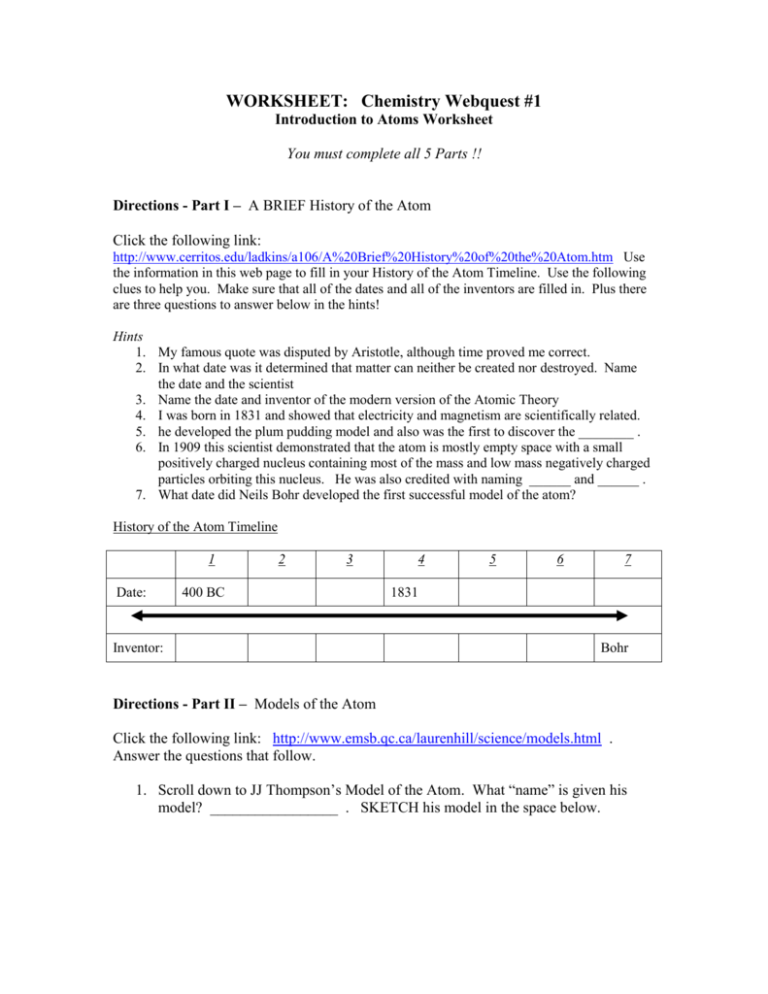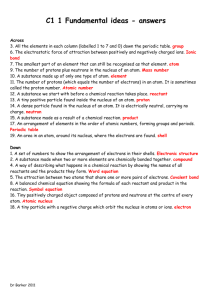Chemistry Webquest #1: Introduction to Atoms Worksheet
advertisement

WORKSHEET: Chemistry Webquest #1 Introduction to Atoms Worksheet You must complete all 5 Parts !! Directions - Part I – A BRIEF History of the Atom Click the following link: http://www.cerritos.edu/ladkins/a106/A%20Brief%20History%20of%20the%20Atom.htm Use the information in this web page to fill in your History of the Atom Timeline. Use the following clues to help you. Make sure that all of the dates and all of the inventors are filled in. Plus there are three questions to answer below in the hints! Hints 1. My famous quote was disputed by Aristotle, although time proved me correct. 2. In what date was it determined that matter can neither be created nor destroyed. Name the date and the scientist 3. Name the date and inventor of the modern version of the Atomic Theory 4. I was born in 1831 and showed that electricity and magnetism are scientifically related. 5. he developed the plum pudding model and also was the first to discover the ________ . 6. In 1909 this scientist demonstrated that the atom is mostly empty space with a small positively charged nucleus containing most of the mass and low mass negatively charged particles orbiting this nucleus. He was also credited with naming ______ and ______ . 7. What date did Neils Bohr developed the first successful model of the atom? History of the Atom Timeline 1 Date: 2 3 400 BC Inventor: 4 5 6 7 1831 Bohr Directions - Part II – Models of the Atom Click the following link: http://www.emsb.qc.ca/laurenhill/science/models.html . Answer the questions that follow. 1. Scroll down to JJ Thompson’s Model of the Atom. What “name” is given his model? _________________ . SKETCH his model in the space below. 2. Scroll down the webpage. What are the four parts to Dalton’s Theory 3. What did Rutherford claim about the nucleus of the atom? 4. Complete this sentence about Bohr: Electrons can only occupy certain _____ _____ around the positive ________ . Directions - Part III – What is an Atom? Click the following link: http://www.qrg.northwestern.edu/projects/vss/docs/Propulsion/1-what-is-an-atom.html Read the top paragraph (only) and answer the following questions: 1. Everything in the universe (except energy)is made up of ______ . 2. Therefore everything in the universe is made up of ______. 3. An atom itself is made up of three tiny kinds of particles called subatomic particles: _______ _________ ________ . 4. The protons and the neutrons make up the ________________ called the nucleus. 5. The _______ fly around above the nucleus in a small cloud. 6. The electrons carry a ________ charge and the protons carry a _______charge. 7. In a normal (neutral) atom the number of protons _______ the number of electrons. Directions - Part IV – What are the Parts of the Atom? Click the following link: http://education.jlab.org/atomtour ; and, answer the questions which follow: 1. How many naturally occurring elements are there? ______ 2. Click the continue button. 3. Click the PROTON. What did scientists discover in 1968? _______________________________________________________________ 4. Click the NEUTRON. When were they first discovered ? _______ . What did the scientists also learn about neutrons? _______________________________________________________________ 5. Click the ELECTORNS and complete this sentence: Its is easy to step off the electrons from an atom and use them to create _________ _________ . Directions - Part V – Common Nomenclature Click the following link: http://education.jlab.org/qa/atoms_and_elements.html ; and, answer the questions which follow: So in summary: an element - a basic substance that can't be ________ . The atom is the smallest amount of an ________ . A molecule contains two or more atoms that are _______ joined together. While a compound i a molecule that contains _______ than one _______ .







